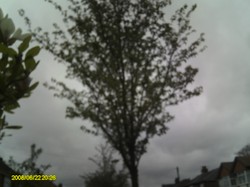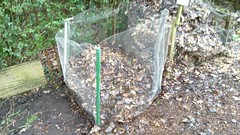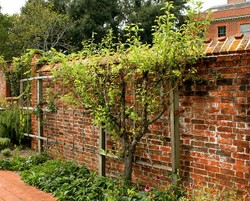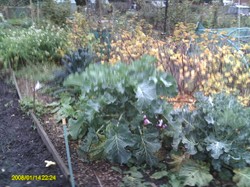Fertilisers are chemicals that stimulate plant growth, but the industry that produces them is oil-based, and as oil becomes more expensive and scarcer, fertliser will be more costly as well. We need to look at sources of nourishment for our farms and gardens, and the most reliable sources are organic ones. There are many organic materials that you can use to enhance the richness of your soil. Many are easily available to farmers and gardeners, and I will explain them in detail here.

Soil Enhancers
by frankbeswick
There are several different organic materials that can enrich your soil
Plant nutrients
There are certain nutrients that are necessary for plants. If you buy fertiliser you will see an NPK ratio expressed as a number: e.g, 5:4:7. This is the proportion of the elements nitrogen, to phosphorus, to potassium, three key ingredients of plant life. But you can also add carbon, and there are many trace nutrients: e.g. calcium, sodium,copper.manganese, magnesium, iron, sulphur and boron, which are needed by various plants, sometimes in different, but slight amounts, and whose deficiency in soil produces recognizable symptoms.
Sometimes quite naturally occurring substances can be applied to your fields. It is now forgotten by many growers that in London upto the twentieth century the carts that brought the hops from the Kentish hopyards to breweries in London came back loaded with soot from London's chimney sweeps, and the soot, once allowed to mature for a short time, was added to Kentish fields. The garden of England was being enriched by the waste from the Carboniferous period.Ash from bonfires was also spread on ground and is rich in potassium.
The Scots and the Irish were great users of seaweed to fertilise their grounds. Seaweed gathered from the beaches would be spread on the fields or lazybeds, which were raised beds made from sand, soil, manure and seaweed for growing vegetables. Strangely seaweed, once the salt has washed off, is no more salty than land plants. When spread it breaks down into a thin powder. It is very rich in essential elements and so is a great soil enhancer. A particular type is calcifed seaweed, which is found on the seabed off Cornwall, but it is becoming scarce and seemed to have disappeared from garden centres, though I saw some recently.You can apply seaweed as meal or in liquid form, and the latter, which is applied by mixing with water, is more easily taken up by plants than the former.
A third and relatively novel substance is rockdust. This is ground granite made from quarry waste. When sprinkled on your soil it is a great enhancer of mineral content, and you do not need much. As soils in Europe and America have been losing minerals at an alarming rate through modern agriculture, the use of rockdust can be a soil saver. I have dosed my plot twice with it, and I have not been disappointed with the vegetables that I am getting.
A fourth source, and please do not think that I am being grim, is to bury dead animals in a plant bed. We buried my brother's guinea pig beneath the roses when I was seventeen, and that year we had our best blossoms. In fact monks often used to be buried in the monastery orchard.
Soil enhancers
 | 10 Lbs of Azomite - Organic Trace Mineral Soil Additive Fertilizer - 67 Trace Minerals: Selenium,... A to Z Minerals- A Complete Organic Fertilizer A Source of Minerals & Trace Elements Azomite is the name of a special rock in Utah. Early this century geological prospector Roll... |
 | Nature's Footprint Glacial Rock Dust Soil amendment, 5-Pound Glacial Rock Dust is a soil amendment containing a broad range of trace minerals, many of which have been slowly lost through the ages on commercial farmland, by erosion, leachi... |
Manure
The great soil enricher is animal dung. There are various types. Cattle manure is popular, so is horse manure, though the latter is often full of weed seeds. Manure should not be applied raw, as it needs time to mature and become well-rotted. Too early an application can burn your plants, as the chemicals can cause a heat flow from the plant which produces burn symptoms. Sometimes, though, you can obtain manure in pelleted form, which is often nutrient enhanced. I have used much of this recently in combination with compost, as it is easier to work than manure in its natural form, which can be very heavy when wet. Animal manure is rich in nitrogen. This is important, as soils tend to constantly recycle nitrogen and it needs replacement.
Chicken manure and poultry manure in general is very rich, and should be applied in moderation when well-rotted. I am hoping for a delivery in the next week or two. In fact we have been using bird manure for many years. Guano, shipped from Chile and some Pacific Islands in large quantities is fossil bird dung accumulated over millenia. It is a natural and rich supply of phoshorus.
Mention must be made of worm compost, which is really a kind of dung. This is produced in a worm composter, and is made from food, cooked or not [but not meat] which is fed slowly to worms. The worms used are not earthworms, but compost worms, such as brandlings. These cannot survive in soil, but need the warmth of compost heaps.It is very rich and should be applied sparingly. There is also worm liquid which is worm urine, this is exceptionally rich. Drained off from the bottom of the composter, it should be applied by being mixed with water in a can and sprinkled around. Urine in general is useful, and can be added to compost heaps.
Manure
 | Hoffman 20505 Dehydrated Super Manure 4-2-3, 5 Pounds 4-2-3 Dehydrated supermanure is easy to apply pelletized form. Improves soil texture; builds humus content without burning. Produces outstanding results in flower and vegetable ... |
 | Earthworm Castings, 15 lb Earthworm castings (1-0-0) are one of nature's most abundant and effective fertilizers. A rich, odorless, all-natural organic product that is extremely cost-effective because yo... |
Compost
Compost is decomposed vegetable matter. I make two kinds. There is a set of compost bins at he end of the allotment for the waste from the garden, and any weeds are committed there. The second type is my black plastic bin, which takes any kitchen waste that I cannot re-use [not cooked, it attracts rats.] This is a rich type of compost.
It is important to realize that compost heaps are produced by combustion, and thus they need air. This means that they must be turned at a regular basis. One trick that I have tried is to lay a pallet on the ground and heal the waste above it. This acts as a funnel for air to come from underneath, and it is notable that the compost is produced quite quickly this way. Beware, though. The heap gets hot. My younger brother, a foundry engineer and an able gardener, once made the mistake of testing his compost heap by sticking his hand full in, thinking that as a foundry man he was used to heat. Mistake! Seventy degrees centigrade is too much even for a hardened foundryman. You will notice the heap shrinking as it decomposes. Occasionally heaps will set alight, though I have never seen it happen. You can buy compost accelerator to speed up the decay process, but human urine is the natural agent for this. You will know that your compost is ready when it is black, crumbly [friable] and most of the original ingredients unrecognizable.
It is also important to get the balance of ingredients right. Too much grass or green, nitrogenous material will make for an accelerated heating process, which will suck up all the oxygen and make an anaerobic, smelly mass. Get a mixture of green and woody material. Chipped wood can be usefully added, as can shredded paper.
When we have mussels I will break up the shells and add them to the heap, so that the compost will get some calcium. Some farmers add bone mea to their land [not the compost] as a source of calcium, but many advise that when using bone meal, always use gloves. There are rumours that it might be a source of infection. Blood, fish and bone, a common fertiliser, very useful, is subject to the same advice. Lime is good also for potatoes.
Compost
 | Worm Factory 360 WF360G Worm Composter, Green " Composting with worms allows you to turn kitchen scraps, paper waste and cardboard into nutrient-rich soil for your plants. The Worm Factory 360 composting system makes the en... |
Leaves, leaf mould and others.
Leaves are a great source of soil structure. While brown leaves have little or no nutrient value, the lignin within them aids to the structure of the soil, thus enabling aeration and water retention. Leaves should not be added to the compost heap, as compost and leaf mould are made by different processes: compost is made through bacterial decay, whereas leaf mould comes from fungal action. Thus you need a separate leaf mould bin for it, distinct from the compost heap.
Leaves can be a great ground protector, as a mulch of them protects the soil from heavy winter raindrops and the damage that they cause, while keeping the ground warm by shielding it from frost. I like to lay down leaves and wet them so that they will be too heavy to blow away in the winds that trouble my exposed plot.
Soil structure can also be aided by peat, which is great for drainage, but it has little nutrient value. However, there are serious issues about how peat is extracted and opinions differ greatly as to whether you should use it. A modern alternative is coir, made from coconut husks.
compost bin
 | Epica Stainless Steel Compost Bin 1 Gallon If you routinely save food scraps for your compost pile, it's time you traded up from that ugly and eco-unfriendly plastic pail you've been using, to this stylish canister that ... |
 | Exaco Trading ECO-2000 2.4 Gallon Kitchen Compost Waste Collector Making your own compost starts in the kitchen by collecting all your organic waste and adding it to your outdoor composter. As much as 30% of household waste can be composted an... |
Conclusion
Soil is the product of organic materials, and so adding organic materials to the soil in suitable form and in an intelligent, informed way will enrich it. Civilisations rise and fall on their soils, for if the soil fails so do they. By being organic you can help maintain the soil on which the fragile existence of humans on this Earth depends. Keep your soil rich and try to make it deeper.
You might also like
Growing in confined spacesAs the world urbanizes and land pressures grow, many people are turning to im...
As Winter ComesFor true allotment gardeners gardening does not cease in winter,




 Women of the Gospelson 10/11/2025
Women of the Gospelson 10/11/2025
 Religious Gardenson 08/25/2025
Religious Gardenson 08/25/2025
 Doctor of the Church: John Henry Newmanon 08/03/2025
Doctor of the Church: John Henry Newmanon 08/03/2025
 Restoring the Palm Houseon 07/16/2025
Restoring the Palm Houseon 07/16/2025



Comments
The council collects waste and composts Ii, It is.it ihen sold to whoever wants to buyi it.The proceeds go to municipal funds
Thank you for your comment below in answer to my previous observation and question.
Is the municipal-council hot-composting collection initiated for municipal-council grounds or for other municipal grounds or for business and resident use?
No. All food groups are used. But cooked food goes into the municipal coun il collection for hot composting. This is to prevent rat infestation.
The third subheading, Composts, advises us that "Compost is decomposed vegetable matter. I make two kinds. There is a set of compost bins at he end of the allotment for the waste from the garden, and any weeds are committed there. The second type is my black plastic bin, which takes any kitchen waste that I cannot re-use [not cooked, it attracts rats.] This is a rich type of compost."
Is there any food group that is not included in your kitchen-waste compostables?
If so, what might you do with such non-compostable kitchen waste?
(I try backyard burning -- the non-big-city county here will permit outdoor burning -- what tends not to turn compost-friendly)
Yes. They would work well.
Thank you!
Some Unitedstatesians leave empty coffee ground-lodging metal containers lying sideways, right side-up, upside-down in their gardens or in the uncultivated areas of their lawns.
Others make holes in metal-can bottoms for putting in soil topped by edible or ornamental plants. They sturdy them within planting-holes.
Would either practices work your pond-side-ward?
Yes, but it did not last long.
Thank you!
It's rather common in certain Unitedstatesian areas to have big rocks for landscape architecture if not for leaching micronutrients also.
(Was there ever a "pet rock" fad in the British Isles?)
I had not heard of this practice. Thanks. But you would have to select your rock carefully. Gneiss, already leached, would be useless.
Thank you!
Some Unitedstatesians have some bigger rocks and some metal cans in their gardens.
The two latter additions manage to muster up some leachable micronutrients alongside other natural fertilizers.
Might that be something that occurs in British-Isles gardens?